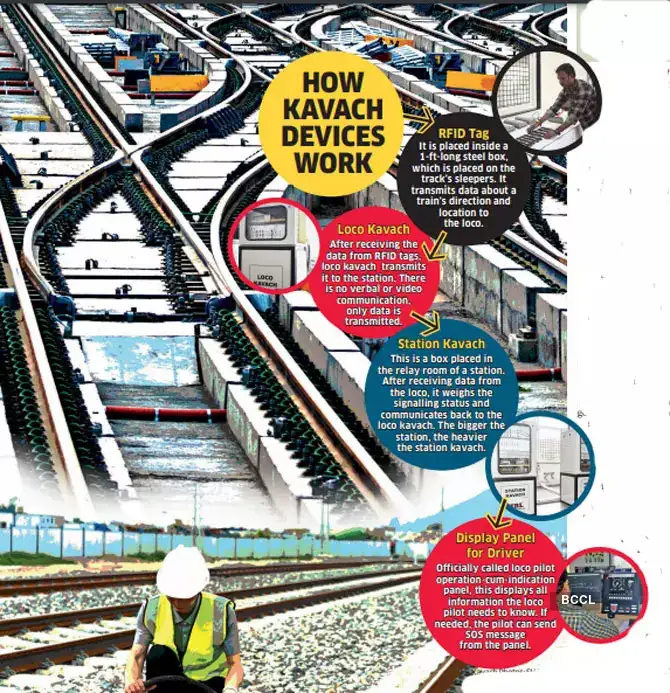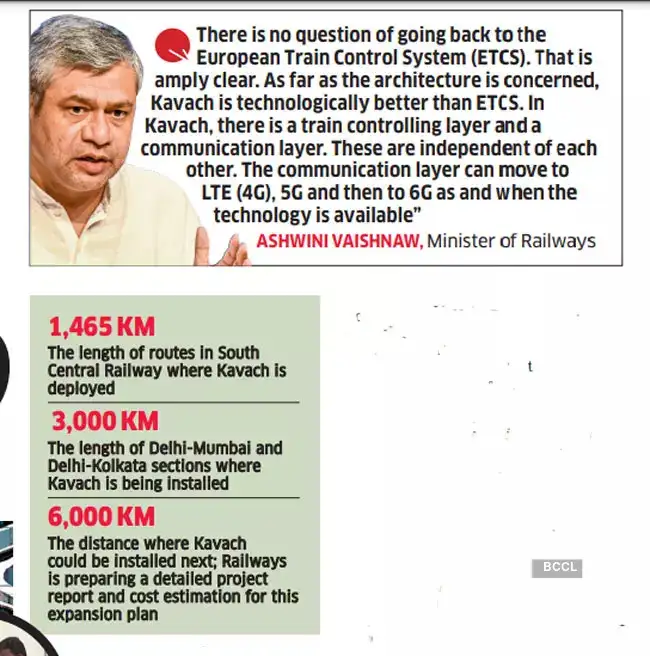A year later, in 2017, the project was in a shambles. The Railways decided to install Europe’s ETCS Level-1 in 10,000 km, a decision that meant a death knell for Mansukhani’s pet project. The engineer, who had been burning the midnight oil in RDSO’s lab to develop an automatic, indigenous train protection system since 2012, was transferred to a routine railway administrative job in Madurai.
Read More: Railways’ Kavach tech can be exported in five years
But as luck would have it, Railway Board honchos realised that ETCS Level 1 was becoming obsolete. And Rail Tel’s invitation of bids for ETCS Level-2 in 2020 resulted in bidders quoting exorbitant prices. This forced the Railways to scrap the idea of purchasing European hardware. The national transporter quickly resuscitated the Indian version and gave it a new name— Kavach, meaning armour. In May 2022, a centre of excellence for Kavach was commissioned in Secunderabad with Mansukhani as its head.
As ETCS and Kavach are similar but incompatible technologies, it is apparent that the Railways has gone for Kavach and discarded its European counterpart.
While talking to ET, Minister of Railways Ashwini Vaishnaw confirms that. “There is no question of going back to the ETCS. It is amply clear. As far as the architecture is concerned, Kavach is technologically better than the ETCS,” he says.
ARMOUR FOR TRAIN
How well can Kavach protect you during your train travel? ET visited Railways’ R&D facility for Kavach in Secunderabad to find an answer to this and many other questions on railway safety.
Even as the number of consequential train accidents fell in the last one decade —from 122 in 2012-13 to 48 in 2022-23—the question on railway safety resurfaced again this year when an accident involving three trains. two passenger and one freight, occurred in Odisha’s Balasore on June 2, killing 296 people. It was one of the deadliest train accidents in independent India. Then, in October, two passenger trains collided in Vizianagaram in Andhra Pradesh, killing 14 and injuring 50.
“Even with Kavach, the Balasore accident could not have been averted as wires got swapped manually,” says an engineer working in the Kavach lab. “But the Andhra accident would not have taken place had both the passenger trains been fitted with Kavach,” he adds, requesting anonymity. Another engineer says, “Nearly half of Indian railway accidents happen due to signal passed at danger or SPAD.” This refers to a train passing a stop signal without authorisation. “Kavach can eliminate all such accidents,” he adds.
Mansukhani refused an interview with ET but allowed this writer to spend some time in the Kavach lab housed inside the Indian Railways Institute of Signal Engineering and Telecommunications.

COMBO OF DEVICES
Kavach—which has been deployed in 1,465 route km on South Central Railway (Telangana: 684 km, Andhra Pradesh: 66 km , Karnataka: 117 km, Maharashtra: 598 km)—is a combination of devices that prevents the loco pilot or train driver from jumping signals and overspeeding. It can also guide a train during inclement weather like dense fog. If a loco pilot fails to apply the brakes, Kavach can do it. There is also a provision for auto whistling at level crossing. Most importantly, it prevents collision of trains, thanks to direct loco-to-loco communication.
How does this technology work? The basic data about a train’s location and direction is generated by RFID tags that are placed on tracks. This data gets transmitted to the loco kavach, which is a large box in the engine. The RFID tags enable the loco to understand where the train is located. Then the loco communicates the data to the nearby station, which gathers intelligence on the next signal. The station then relays the signalling information back to the loco, which then calculates the braking distance and applies brakes automatically in case it spots any hurdle. The braking distance differs from one train to another. For instance, a heavily loaded goods train will need more than 1 km to stop while a Vande Bharat needs only 800 metres to stop after brakes are applied. Depending on the type of trains, Kavach figures out when to press the brakes.
Sudhanshu Mani, the architect of the indigenously developed semi-high speed Vande Bharat, tells ET that he would give more marks to Kavach than to Vande Bharat. “Both Vande Bharat and Kavach are indigenously built. Yet unlike Vande Bharat, the concept of Kavach is novel,” he says, adding that this unique and comprehensive signalling system is almost at par with ETCS Level-2 but is much cheaper.
“However, the rolling out of Kavach is very slow particularly when the technology is well accepted and funding is not an issue,” says Mani, who was general manager of the Integral Coach Factory of Chennai when the first piece of Vande Bharat was manufactured in 2018.

Now, Kavach is being installed by three approved vendors in 3,000 kilometres of Delhi-Mumbai and Delhi-Kolkata sections. All three vendors—Medha Servo Drives, HBL Power Systems and Kernex Microsystems—are Indian companies. While their businesses are likely to grow if the Railways sets the ball rolling on Kavach expansion, by expediting the preparation of a detailed project report for another 6,000 km, the industry does not seem upbeat. “At this stage what we need is some clarity,” says Srinivas Reddy, director of Medha Servo Drives, a Hyderabad-headquartered company that is executing a Rs 650 crore project for installing Kavach in 900 route km and 200 locomotives. “We should know the Railways’ Kavach rollout plan months before we complete the Delhi-Mumbai and Delhi-Kolkata sections, likely by May next year. Unless we have some clarity, we won’t be able to import the necessary components and get ready for the next round of bidding,” he says, adding that two more private players may join the race. “We are offering devices at one-third of the cost of ETCS Level-2,” he says, adding that the industry is capable of manufacturing more Kavach units, provided the Railways lays out a roadmap and offers private players enough time to prepare for the next stage.
In a written reply to a question in Lok Sabha in August, the Ministry of Railways said the cost of Kavach equipment is about Rs 50 lakh per km while that of the equipment to be placed in loco is Rs 70 lakh. So far, the ministry had spent Rs 352 crore in Kavach implementation, it informed the Parliament. Clearly, there is no resource constraint as the budgetary allocation for Kavach in FY2024 is Rs 710 crore.
Despite all the emphasis on Kavach, it is not enough to achieve an accident-free train journey. Former Railway Board chairman VK Yadav says the national transporter has been adopting a multipronged strategy to mitigate accidents. With the elimination of unmanned level crossings across the country and a clear emphasis on timely track renewal and provision of electronic interlocking at all stations, the number of accidents is bound to reduce, he says.
“To tackle the menace of human negligence, particularly when the overall train speeds are increasing, Kavach is an effective tool,” says Yadav, adding that the Railways should implement its cadre restructuring proposal approved by the Union cabinet three years ago. “For better R&D, technical personnel of the Railways should focus on their particular domain just as scientists in organisations such as the DRDO in India and the Railway Technical Research Institute in Japan do. There should be a separate management cadre for running the Railways,” he says.
There are mixed signals, too. While the Railways has given the go-ahead to acquire Kavach, the Delhi-Meerut Regional Rapid Transit System (RRTS), a regional rail that comes under the Union Urban Affairs Ministry, has gone ahead with a hybrid version between ETCS Levels 2 and 3. However, in January, Vinay Kumar Singh, MD of the National Capital Region Transport Corporation, which owns the RRTS in NCR, had said, “Our signalling system is better than what is being deployed in Europe.”
Mani says “the Railways should take up this issue with the Ministry of Urban Affairs”. “We should go for indigenous technology across all platforms,” he says, adding that if this technology is widely accepted in India, it will have export potential. “I won’t be surprised if countries such as Brazil, Turkey, Indonesia and Malaysia import Kavach rather than ETCS Level-2,” he says.









